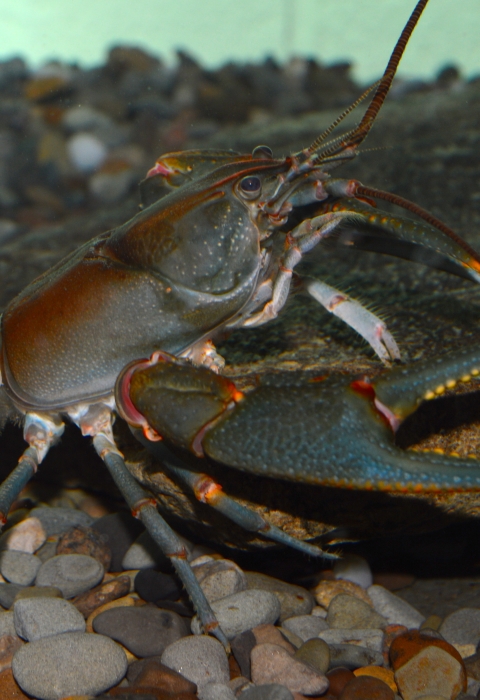Overview
The Big Sandy crayfish is a freshwater crustacean found in streams and rivers in the Appalachian Region of Kentucky, Virginia and West Virginia. We have been working with state partners to determine where this dynamic creature is found, and whether it is in danger of extinction. In May 2016, the U.S. Fish and Wildlife Service listed the Big Sandy crayfish as a threatened species, protected under the Endangered Species Act.
Scientific Name
Identification Numbers
Characteristics
Habitat
The Big Sandy Crayfish needs clean, medium-sized streams and rivers for its social reproductive and energetic needs. They are usually found in faster moving sections of the water, in areas with large boulders and rocks, and little sedimentation or pollution. The stream reaches are at higher elevations in the Appalachian mountain region, in areas with steep hills and ridges that are dissected by a network of deeply cut valleys.
Food
Big Sandy crayfish are opportunistic omnivores, which means they feed on both plants and animals, living and dead, that are readily available in their habitat. Big Sandy crayfish play an important role in stream environments by recycling animal and plant matter and serving as food for other wildlife, including sport fish.
Behavior
Big Sandy crayfish shelter in shallow excavations under loose stones and boulders on stream bottoms. Crayfish can move forward and side to side by using their walking legs. They can also move backward by quickly tucking their segmented abdomen underneath them.
Physical Characteristics
Big Sandy crayfish resemble small lobsters. They have a segmented body, eight walking legs, swimmerets and two large claws.
Measurements:
Length: 3 to 4 in (75.7 to 101.6 mm)
Big Sandy Crayfish appear olive brown to light green coloration to blend in well with stream bottom habitat. The walking legs of the Big Sandy crayfish range from light green to green blue to green. The pincher claws, or chelae, are usually aqua, but sometimes green blue to blue. Red accents appear around the eyes and legs.
Life Cycle
Big Sandy crayfish can live five to seven years.
Big Sandy crayfish reproduce between three and four years of age.
Similar Species
The Guyandotte River crayfish and Big Sandy crayfish are closely related, sharing many physical characteristics.
Geography
The Big Sandy crayfish is known only from the Big Sandy River Basin in eastern Kentucky, southwestern Virginia and southern West Virginia. The main river and its streams flow northward until it joins with the Ohio River. Records of the Big Sandy crayfish’s presence in from the Virginia portions of the Big Sandy Basin date to 1937, when a single specimen was collected from the Russell Fork drainage in Dickenson County, Virginia. A series of surveys conducted in following years confirmed its presence in West Virginia and Kentucky. The Big Sandy crayfish once had a wider range, but widespread habitat loss and fragmentation of its streams have significantly reduced places where it can be found.
Timeline
Explore the information available for this taxon's timeline. You can select an event on the timeline to view more information, or cycle through the content available in the carousel below.
10 Items